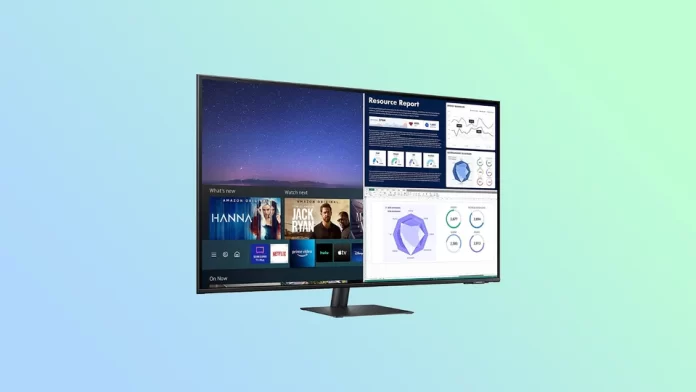Smart TVs have come a long way in recent years, offering consumers a wide range of features and capabilities that were once only available on computers. Today, many modern Smart TVs have features (such as screen refresh rate) that make them suitable for use as computer monitors.
So the short answer is YES, but there are some essential things to consider before doing so. Let’s look at them in more detail.
Reasonability for using Smart TV as a computer monitor
The first and most important thing to know is whether it is appropriate for you to use the TV as a monitor for your PC. For example, the TV will be the right choice if you want to play video games on a big screen with good resolution. This way, your PC can replace PlayStation or Xbox. This is incredibly convenient if you are used to playing on a gamepad.
On the other hand, Smart TVs cannot be suitable for routine office work. If we are talking about work, study, or other activities that involve using a computer mouse and keyboard, the Smart TV won’t match. Theoretically, you can put the TV on your desk or hang it next to it, so all the wires reach the PC. But will it be comfortable for you?
In addition, a Smart TV may not provide the exact resolution or clarity as a regular computer monitor. It’s optimized for video playback and not necessarily for displaying text or other PC content. However, as a temporary solution, Smart TV can be used to browse the internet, check email, watch videos, etc.
Connection details
The second point is the connection details. Smart TV must have the necessary input ports to connect to your computer. Most modern Smart TVs have HDMI ports. Some may also have VGA or DVI ports. In other words, you should decide on the connection type and check whether it is available on both devices.
The most common way to connect a Smart TV to a computer is through an HDMI cable. Most Smart TVs have at least one HDMI port, which allows you to connect your computer to your TV with a single cable. HDMI cables can carry video and audio signals, so you will get an image and sound from your computer through your TV.
To connect your computer to your Smart TV using an HDMI cable, you’ll need to:
- Locate the HDMI port on your TV and your computer.
- Then, plug one end of the HDMI cable into your computer’s port and the other into your TV.
Once the cable is plugged in, your Smart TV should automatically recognize the signal from your computer and display it on your TV screen. The same goes for the other cable types. The only problem with using VGA or DVI is the lack of sound (they do not transmit the audio signal). In this case, connecting the speakers to your PC will be a solution.
Display settings
When you first connect your computer to your Smart TV, you may notice that the picture is not scaled correctly to fit your TV screen. This is because your TV has a different aspect ratio. So you may need to adjust the display settings on both your computer and TV to make the picture look right.
On your computer, you can adjust the display settings by right-clicking on the desktop and selecting “Display Settings” (on Windows) or “System Preferences” > “Displays” (on Mac). From there, you can adjust the resolution, scaling, and other settings to optimize the picture for your TV.
On your Smart TV, the process for adjusting the display settings will vary depending on the brand and model of your TV. However, most Smart TVs have a picture settings menu where you can adjust the aspect ratio, scale, and other settings to optimize the image.
One thing to remember when adjusting the display settings is that you may need to experiment to find the best option for your specific setup. For example, you may need to adjust the scaling on your computer to make the text look sharp and clear on your TV screen. You may also need to adjust your TV’s brightness, contrast, and other settings to get as good picture quality as possible.
Refresh rate
Another thing to consider when using a Smart TV as a computer monitor is the refresh rate. It is the number of times per second a TV refreshes the image on the screen. The higher the refresh rate, the smoother and more fluid the motion appears on the screen.
Most Smart TVs have a refresh rate of 60Hz, which may be lower than what you’re used to on a computer monitor. This can result in a slightly slower and less responsive experience, particularly regarding fast-moving content like gaming or action video. However, a 60Hz refresh rate should be sufficient for basic computer use.
Today there are already Smart TVs with a 120 Hz refresh rate. They provide smoother and more fluid motion, especially regarding fast-moving content such as sports or video games. It can also help reduce motion blur and improve overall image quality.
However, it’s important to note that not all content is created equal, and some may not be optimized for a 120Hz refresh rate. For example, most movies and TV shows are filmed at 24 frames per second, much lower than a 120Hz refresh rate. In these cases, the TV will use a technique called “motion interpolation” to artificially create new frames between the original frames, which can result in a smoother but sometimes unnatural-looking picture.
Another thing to consider is that a 120Hz TV may not necessarily provide a better gaming experience. While a higher refresh rate can help reduce motion blur and improve overall picture quality, it’s not the only factor that affects gaming performance. Other factors like input lag, response time, and color accuracy can also significantly affect the overall gaming experience.
What is better for use with a PC: monitor or TV?
Here are some factors:
Screen size
TVs generally offer larger screens than monitors, making them ideal for watching movies, TV shows, and gaming. However, a monitor may be a better option if you’re looking for a smaller screen for basic computer use.
Resolution
Monitors offer higher resolutions than TVs, making images sharper and more detailed. A high-resolution monitor may be the better choice if you’re looking for a display primarily for productivity tasks like web browsing, document editing, and graphic design. However, if you’re looking for a display for gaming or watching movies, a TV with a lower resolution may still provide a great experience.
Refresh rate
Monitors generally have higher refresh rates than TVs, which can result in smoother motion and better gaming performance. If you’re a gamer or watch a lot of fast-paced content like sports or action movies, a monitor with a high refresh rate may be a better choice.
Connectivity
TVs generally offer more connectivity options than monitors, including HDMI ports, USB ports, and built-in speakers. This can be useful if you need to connect multiple devices to your display or if you prefer to use built-in speakers for audio output. However, a monitor with an HDMI port may be sufficient if you only need to connect your PC to your display.
In conclusion, Smart TVs can also be used as displays for a PC, but the choice depends on your specific needs and preferences. Monitors generally offer higher resolutions and refresh rates, making them ideal for productivity tasks and gaming. In contrast, TVs offer larger screens and more connectivity options, making them ideal for watching movies and TV shows.
Ultimately, the best choice depends on the intended use of the display, and it is important to consider factors such as screen size, resolution, refresh rate, and connectivity options when deciding.




